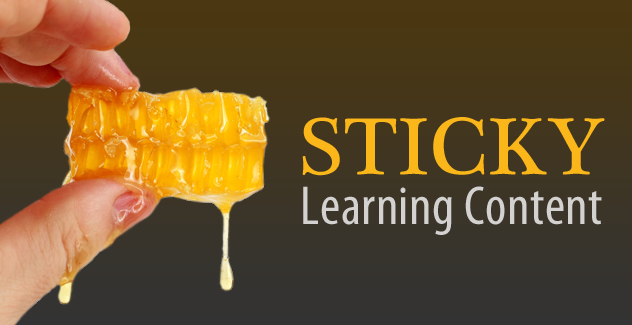
This is the third in a series of blog posts addressing key steps for creating high-quality online learning content. After discussing in the first post (Step 1: Discovering Good Content), the factors to consider in locating usable learning resources, we looked in the second (Step 2: Reusing and repurposing learning content) at the role that context plays in preparing content for student access.
Instructional Design for Online Learning (Step Three): Making Content Pedagogically Effective
The considerations discussed in our last post—the contexts of discipline, content, and learner – will help in determining strategies for instructional design for online learning, and how best to present content to meet student and curriculum needs.
The next step is to use those considerations in organizing how sticky learning content works digitally. Here are some starting points for making the content pedagogically effective online:
Identify outcomes
It’s helpful to give students an overview of what they will learn from the lesson. In addition to learning objectives, it’s good to use an advanced organizer for the content to be presented.
Provide learning support
This may mean illuminating important information in some way, highlighting or adding additional details. Adding visuals and multimedia, when possible, is useful for providing different perspectives, while also accommodating different learning styles.
Check understanding on the fly
Rather than waiting to provide feedback on learners’ comprehension until the end of the lesson, it’s useful to do that all the way through. Ensure sticky learning from the get-go; make sure learners get each point as it is presented, so as to build up knowledge as the lesson progresses.
How Learning Content Works Digitally
The process and principles involved in presenting content digitally to students are no different from what we all do as teachers in the classroom.
In preparing to introduce new learning content, we provide some initial indication of what the new unit is about and how it connects to previous content. Part of that process is likely to be diagnostic probing to see to what extent students are already familiar with some concepts to be covered.
As we present sticky learning content to students, we don’t do it all at once, but rather check to see if students are absorbing it before we move on. To the extent possible, we illuminate the content with materials beyond the textbook, often from online sources.
Here are some of the concrete ways this process can take shape digitally:
Introduce the unit
Provide main concepts of the unit succinctly, maybe in bullet points. A short pre-test can be helpful in determining what students already know, while at the same time introducing key concepts.
Media such as an image or short video also provide good starting points in sticky learning.
Chunk the content
Present the content in reasonably digestible segments, rather than one long web page—it’s easy to lose context when having to scroll up and down.
Enrich the material
Annotate key terms and highlight essential concepts, providing definitions, examples, or media through links, parenthetical comments, embedded audio/video, or pop-ups.
Interactive learning exercises enable students to work with content, providing more time on task and learning reinforcement.
Provide linked content
Illuminating the content from different perspectives promotes sticky learning and additional materials from online sources can easily be integrated as well. That could be done on the main content window, in a sidebar or other content containers.
Give feedback
Formative assessment can be included on each page.
Feedback can be generic, or more specifically tailored to student responses. In-line formative assessments help keep students alert and on track. They can provide encouragement (through positive feedback) and indicate to the student the most salient aspects of the content.
Show next steps
Some students may want to further expand their knowledge. It’s good to provide additional resources for learning more.
Looking ahead to the next unit is a good way to end an online lesson. This strategy promotes sticky learning that will benefit the student as they move from lesson to lesson.
SoftChalk Cloud makes it easy to create-your-own sticky interactive activities from flashcards to timelines. Visit our Interactivity and Engagement page for details.
In the fourth post (Step 4: Assessing Learning Outcomes), we discuss how to make sure learning objectives are met in terms of student outcomes and curriculum goals.
About 12: 12, is a founding partner and responsible for product research and design. Prior to SoftChalk, Robert was a founding partner of madDuck Technologies where he was a co-developer of the Web Course in a Box Learning
Management System. He is the former Director of the Instructional Development Center at Virginia Commonwealth University and is currently a faculty member in their School of World Studies. His principal areas of research are in applied linguistics and international studies. He writes a regular column on emerging technologies for the peer-reviewed journal Language Learning & Technology (llt.msu.edu) and blogs on intercultural communication at http://acrossculturesweb.com/wp/.

Leave a Reply